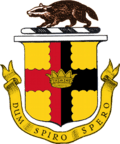Sarawak dollar

The dollar was the currency of Sarawak from 1858 to 1953. It was subdivided into 100 cents. The dollar remained at par with the Straits dollar and its successor the Malayan dollar, the currency of Malaya and Singapore, from its introduction until both currencies were replaced by the Malaya and British Borneo dollar in 1953.
During the Japanese occupation period (1942-1945, paper money was issued in denominations ranging from 1 cent to 1000 dollars. This currency was fixed at 1 dollar = 1 Japanese yen, compared to a 1:2 pre-war rate. Following the war, the Japanese occupation currency was declared worthless and the previous issues of the Sarawak dollar regained their value relative to sterling (two shillings four pence).
Coins
Throughout its history, coins were minted in values of 1⁄4 cent, 1⁄2 cent, 1 cent, 5 cents, 10 cents, 20 cents, and 50 cents. The copper 1⁄4 was the smallest denomination and the first to be discontinued, last being issued in 1896. The 1⁄2 was also always copper and after reductions in size was eventually discontinued in 1933. Starting in 1892 1 cent coins had a hole in the center, but the holed design was later discontinued after 1897. In 1920 the 1 cent was struck in copper-nickel but later reverted to copper in 1927. The 5 and 10 cents were 80% silver until 1920, when they were briefly reduced to 40% silver and then replaced by copper-nickel the same year. The 20 and 50 cents remained silver but were reduced from 80% to 40% starting that same year thereafter. All Sarawak coins carry the portrait and the name of either of the three "White Rajahs" of Sarawak, James Brooke until 1868, Charles Anthoni Johnson Brooke from 1868 to 1917, and Charles Vyner Brooke from 1917 to the end of this currency in 1938.
Banknotes
The first series was issued by the Sarawak Government Treasury. They were hand-stamped notes of low quality. All later notes were issued by the Government of Sarawak except for the 10-cent and 25-cent notes in 1919 (by the Treasury again). Throughout its history, banknotes came in the values of 5 cents, 10 cents, 20 cents, 25 cents, 50 cents, $1, $5, $10, $25, $50, and $100. Anything before 1922 or above $25 is extremely rare.
See also
References
- Pick, Albert (1996). Standard Catalog of World Paper Money: General Issues to 1960. Colin R. Bruce II and Neil Shafer (editors) (8th ed.). Krause Publications. ISBN 0-87341-469-1.
- Krause, Chester L.; Clifford Mishler (2003). 2004 Standard Catalog of World Coins: 1901–Present. Colin R. Bruce II (senior editor) (31st ed.). Krause Publications. ISBN 0873495934.
External links
| Preceded by: No modern predecessor |
Currency of the Kingdom of Sarawak 1858 – 1942 Note: had been at par with the Straits dollar, and the Malayan dollar after 1939 |
Succeeded by: Japanese government-issued dollar Location: present day Malaysia, Singapore, Brunei Reason: Japanese occupation Ratio: at par Note: The Japanese allowed the former currencies to circulate, but they were in practice hoarded as a more reliable store of value. |
| Preceded by: Japanese government-issued dollar Location: present day Malaysia, Singapore, Brunei Reason: Japan lost World War II Ratio: The occupation currency became worthless. The value of the pre-occupation currency was restored. |
Currency of the Kingdom of Sarawak 1945 – 1946 Note: had been at par with the Malayan dollar |
Currency of the Colony of Sarawak 1946 – 1953 Note: had been at par with the Malayan dollar |
Succeeded by: Malaya and British Borneo dollar Reason: creation of a common Board of Commissioners of Currency Ratio: at par, or 60 dollars = 7 British pounds |
